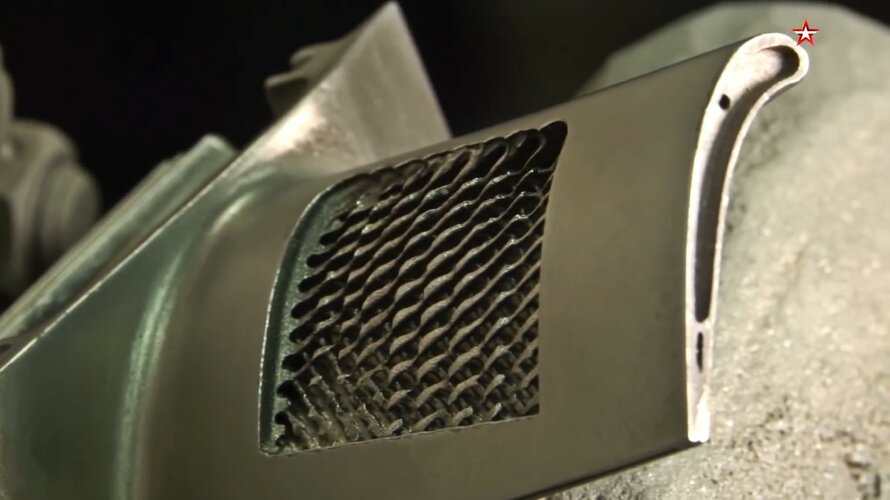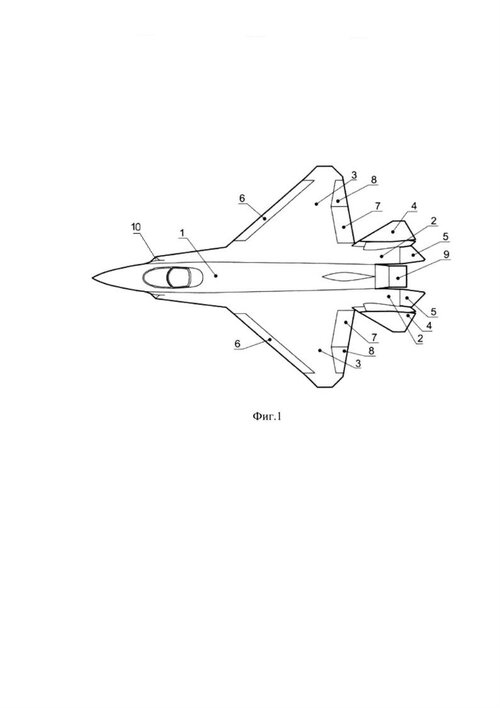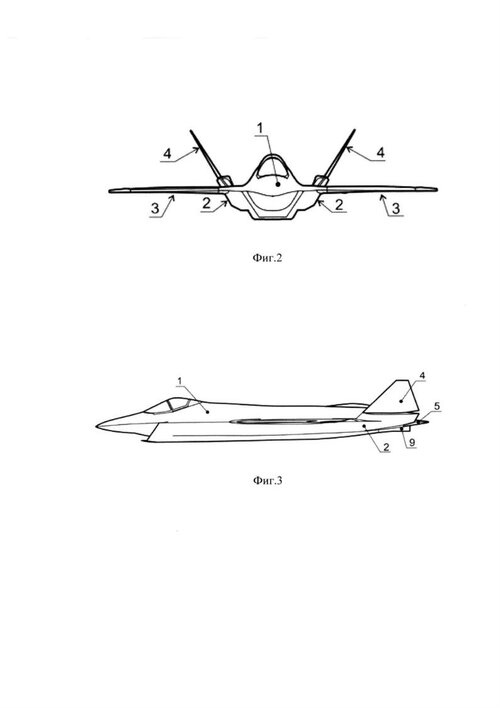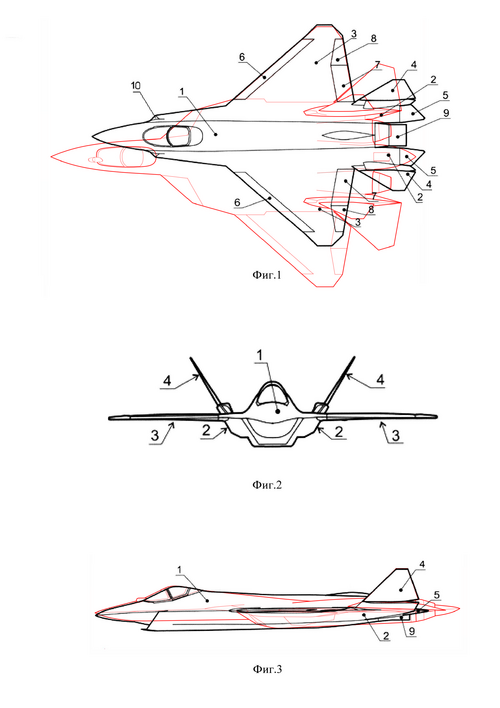(54) LIGHT TACTICAL AIRCRAFT
(57) Abstract:
The invention relates to the field of aviation, in particular to light tactical aircraft with low radar visibility. Light tactical aircraft contains a fuselage with side tail booms, wing panels, tail, air intake, power plant and jet nozzle. The side tail booms are developed and end with parts turning on the horizontal axis. On the wing consoles, which have a large sweep, there are swivel socks and internal and external elevons. The tail assembly is V-shaped, the consoles of which are all-moving, performing the function of both horizontal and vertical tail. The air intake is located in the lower part of the fuselage and partially covers it from the bottom side. The technical result is to increase the stability and controllability of the aircraft without deteriorating the characteristics of radar visibility. 5 z.p. f-ly, 3 ill.
The invention relates to the field of aviation, in particular to light tactical aircraft with low radar visibility.
A supersonic convertible aircraft is known from the prior art (see patent RU 2432299 C2, published on October 27, 2011), which contains a fuselage with a lower air intake and a V-tail.
However, the design of the known aircraft has the disadvantage of insufficient stability and controllability of the aircraft, as well as a sufficiently large radar visibility.
The prior art also known aircraft Lockheed F-117А Nighthawk with low radar visibility, made according to the scheme "tailless with a V-tail" without horizontal tail. On the wing of the known aircraft there are deflectable elevons. Pitch and roll control is carried out by elevons, yaw - by all-moving vertical tail.
However, the disadvantage of this aircraft is poor takeoff and landing characteristics, as well as insufficient stability and controllability of the aircraft.
The objective of the claimed invention is to eliminate the shortcomings of aircraft known from the prior art.
Thus, the technical result, to which the claimed invention is directed, is to increase the stability and controllability of the aircraft without deteriorating the characteristics of radar visibility.
Light tactical aircraft contains a fuselage with side tail booms, wing panels, tail, air intake, power plant and jet nozzle. The side tail booms are developed and end with parts turning on the horizontal axis. On the wing consoles, which have a large sweep, there are swivel socks and internal and external elevons. The tail assembly is V-shaped, the consoles of which are all-moving, performing the function of both horizontal and vertical tail. The air intake is located in the lower part of the fuselage and partially covers it from the bottom side.
The rotary jet nozzle is located along the axis of symmetry of the fuselage and is used for control and balancing in flight and is deflectable in the vertical plane.
Rotary jet nozzle is located along the axis of symmetry of the fuselage and is used for control and balancing in flight and is made all-aspect.
The axes of rotation of the consoles of the V-tail are located perpendicular to the axis of the fuselage.
The axis of rotation of the V-tail consoles are located closer to the leading edge of the consoles.
All edges of the air intake are swept.
Further, the claimed invention is explained in more detail by the drawings, in which:
Fig. 1 - claimed aircraft, top view,
Fig. 2 - claimed aircraft, front view,
Fig. 3 - claimed aircraft, side view.
The claimed light tactical aircraft contains a fuselage (1) with developed side tail booms (2) and an air intake (10) of the power plant, wing consoles (3) and a V-tail (4). The air intake (10) is located in the lower part of the fuselage (1) and partially covers it from the bottom side (see Fig. 2). Wing consoles (3) are made of large sweep (40-55°) and have deflectable wing tips (6). On the trailing edge of the wing console (3) there are internal (7) and external (8) elevons. The side tail booms (2) end in turning parts (5), which act as elevators. V-shaped tail (4) is made all-moving simultaneously plays the role of horizontal and vertical tail, and provides the ability to control the aircraft in the longitudinal channel with in-phase deviation and in the transverse channel with differential deviation, and also provides stability and controllability in the track channel at all flight speeds and provides the function of air braking. Road stability at supersonic flight speeds with insufficient static stability is provided artificially, due to the deflection of the consoles V-tail (4). When a disturbance of the atmosphere or a gust of wind occurs in the track channel, the in-phase deviation of the V-shaped tail surfaces (4) in the direction of parrying the disturbance is carried out. This solution makes it possible to reduce the empennage area, thereby reducing the mass and drag of the empennage and the aircraft as a whole.
The axes of rotation of the consoles of the V-tail are located perpendicular to the axis of the fuselage and are located closer to the leading edge of each console.
Wing mechanization (3) is used to provide control in the pitch and roll channels, to increase lift. The rotary toe (6) of the wing is used to increase the critical angle of attack and ensure a shockless flow around the wing (3), for flight "along the polar envelope" in the takeoff, landing, maneuvering and cruising subsonic flight modes. The elevons (7, 8) are designed to control the aircraft in pitch by in-phase up-down deviation, to increase lift during in-phase downward deviation in various modes by increasing the curvature of the wing median surface, and to control roll in case of differential deviation. When providing the air braking function, the elevons (7, 8) deviate together with other organs in such a way that
The rotary parts (5) of the side tail booms, when deflected up and down, are used for pitch control, performing the functions of an elevator, in takeoff and landing modes they serve to compensate for the dive moment that occurs when the elevons (7, 8) are deflected to increase the wing lift. When providing the air braking function, the rotary parts 5 deviate together with other bodies, providing an increase in resistance and a zero increment in the total pitching moment.
The execution of all edges of the air intake swept provides a reduction in the level of radar visibility of the aircraft.
Rotary jet nozzle (9) of the aircraft engine is located along the axis of symmetry of the fuselage and is used for control and balancing in flight;
All available controls (V-tail, wing tips, elevons, rotary parts of the beam) while deflecting increase aerodynamic drag, thereby performing the function of brake flaps.
The presence of all the above controls in the design of the aircraft together make it possible to move the zones of occurrence of unbalanced static instability of the aircraft in the longitudinal and track control channels to the range of angles of attack of 15 ° or more, to increase the bearing properties and reduce the resistance of this aerodynamic layout of the aircraft, which is confirmed by calculations and testing the model in wind tunnels, and allow us to have operational angles of attack, the level of aerodynamic quality, providing a significant improvement in cruising, maneuvering and takeoff and landing characteristics compared to known analogues.
Given the layout of a light tactical aircraft due to the claimed design provides maximum controllability of the aircraft in any flight modes and does not increase the radar visibility of the aircraft.
Claim
1. A light tactical aircraft containing a fuselage with side tail booms, wing consoles, tail assembly, an air intake, a power plant and a rotary jet nozzle, characterized in that the side tail booms are developed and end with parts turning on a horizontal axis, on wing consoles having large sweep, swivel socks and internal and external elevons are located, and the tail unit is V-shaped, the consoles of which are all-moving, performing the function of both horizontal and vertical tail, and the air intake is located in the lower part of the fuselage and partially covers it from the underside.
2. Light tactical aircraft according to claim 1, characterized in that the rotary jet nozzle is located along the axis of symmetry of the fuselage and is used for control and balancing in flight and is deflectable in a vertical plane.
3. Light tactical aircraft according to claim 1, characterized in that the rotary jet nozzle is located along the axis of symmetry of the fuselage and is used for control and balancing in flight and is made all-aspect.
4. Light tactical aircraft according to claim 1, characterized in that the axis of rotation of the consoles of the V-tail is perpendicular to the axis of the fuselage.
5. Light tactical aircraft according to claim 4, characterized in that the axis of rotation of the V-tail consoles is located closer to the leading edge of the consoles.
6. Light tactical aircraft according to claim 1, characterized in that all edges of the air intake are swept.










